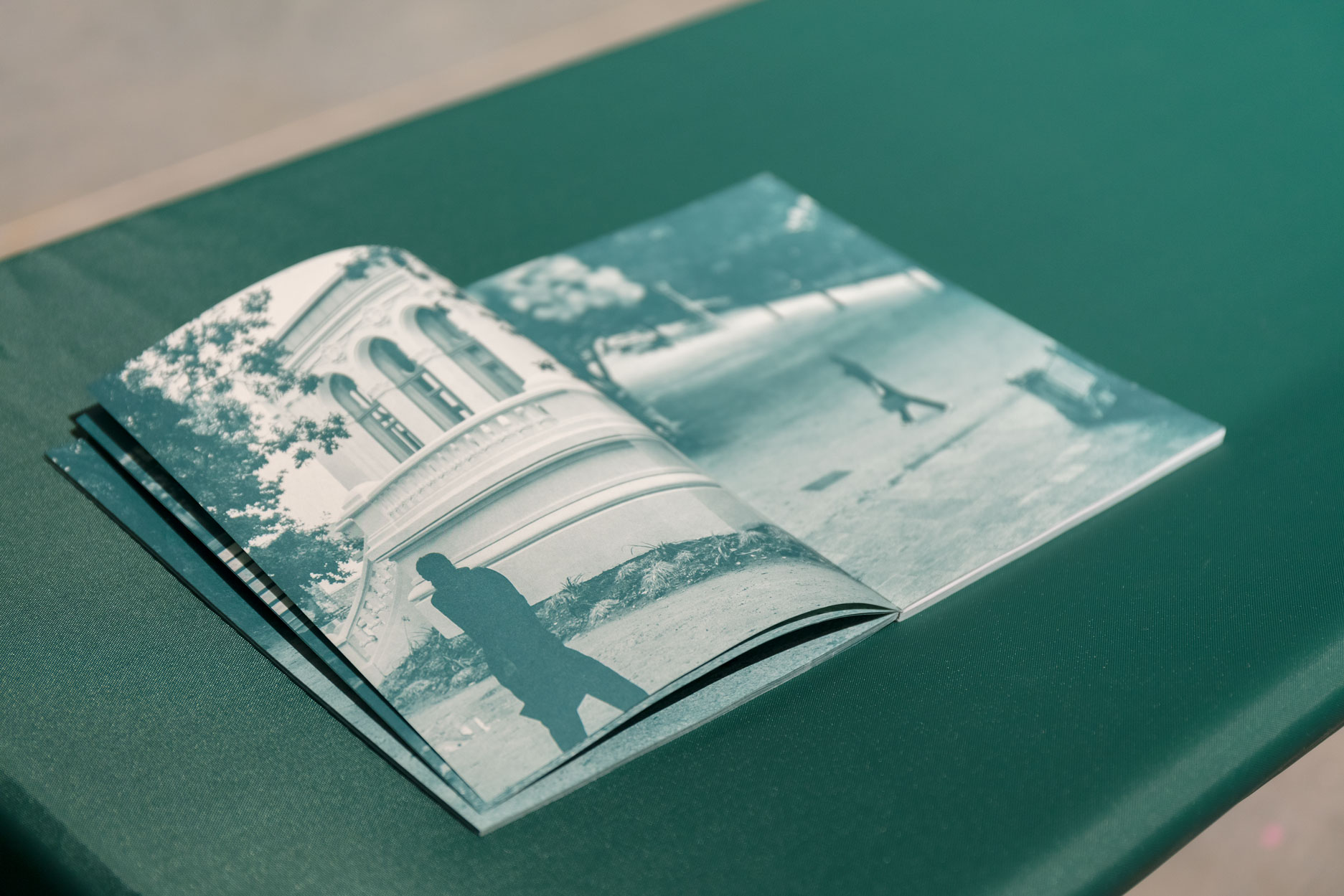
incohérent walk, 2019.
Walking through green spaces
of Santiago de Compostela
dressed in green clothes
carrying a green painting.
irene grau’s latest project, incohérent walk, starts from the context of one of the first monochromes in history, developed by Les Incohérents, a late 19th century Parisian group of witty artists organized by a young writer, Jules Lévy. Among the radical Incoherent works on view in their early 1880s exhibitions were blank monochrome paintings by the poet Paul Bilhaud and the French journalist and humorist Alphonse Allais. The monochrome was born as a conceptual joke, precisely to belittle the work, in the form of graphic criticism, of artists such as Turner, Whistler, or Monet, whose landscape paintings eliminated the contrasts of chiaroscuro that defined the forms. In his well known Album Primo-Avrilesque, published on April 1, 1897, Allais compiled a series of colored plates with titles ranging from First Communion of Anaemic Young Girls in the Snow to Tomato Harvest by Apoplectic Cardinals on the Shore of the Red Sea (Aurora Borealis Effect). These satirical gestures represent one of the earliest examples of monochrome painting through an ambivalent relationship to language and landscape.
It’s through knowledge of the past and Art History that irene grau’s conceptual projects gain significance and move forward in the contemporary redefinition of the landscape genre, as well as the idea of displacement, a core concept in her art practice.
Site-specific: books, headphones (walk sound landscape), clothes, benches and wall paint.
Paseo por los espacios verdes
de Santiago de Compostela
vestida de verde
llevando un cuadro verde.
El úlimo proyecto de irene grau, incohérent walk, parte del contexto de uno de los primeros monocromos de la historia desarrollado por Les Incohérents, un colectivo parisino de finales del siglo XIX formado por un heterogéneo grupo de (no)artistas y organizado por el joven escritor, Jules Lévy. Entre las propuestas radicales de los Incoherentes expuestas a principios de 1880 se encuentran una serie de imágenes monocromas del poeta Paul Bilhaud y del periodista y humorista francés Alphonse Allais. La idea de monocromo surgió como una broma conceptual precisamente como burla, en forma de crítica gráfica, a las pinturas de artsitas como Turner, Monet o Whistler, cuyos paisajes finalmente perdieron los contrastes de claroscuro que definían las formas. En su conocido Album Primo-Avrilesque, publicado el 1 de Abril de 1897, Allais reunió una serie de láminas de color con títulos que iban desde Primera comunión de niñas anémicas en la nieve a Cardenales apopléticos recogiendo tomates en la orilla del Mar Rojo (Efecto Aurora Boreal). Esta serie de gestos satíricos supone uno de los primeros ejemplos de pintura monocroma desde una relación ambivalente tanto con el lenguaje como con el género del paisaje.
Y es a través del conocimiento de lo pasado y de la Historia del Arte cómo las propuestas conceptuales de irene grau obtienen significado y van más allá en la redefinición contemporánea del paisaje como género, a partir especialmente de la idea de desplazamiento, un concepto central en su práctica artística.
Site-specific: libros, auriculares (paisaje sonoro del paseo), ropa, bancos y pintura de pared.
-
 incohérent walk. Installation view at AEIVA, Birmingham, US, 2019.
incohérent walk. Installation view at AEIVA, Birmingham, US, 2019.
-
 incohérent walk. Installation view at AEIVA, Birmingham, US, 2019.
incohérent walk. Installation view at AEIVA, Birmingham, US, 2019.
-
 incohérent walk. Installation view at AEIVA, Birmingham, US, 2019.
incohérent walk. Installation view at AEIVA, Birmingham, US, 2019.
-
 incohérent walk. Installation view at AEIVA, Birmingham, US, 2019.
incohérent walk. Installation view at AEIVA, Birmingham, US, 2019.
-
 incohérent walk. Installation view at AEIVA, Birmingham, US, 2019.
incohérent walk. Installation view at AEIVA, Birmingham, US, 2019.
-
 incohérent walk. Installation view at AEIVA, Birmingham, US, 2019.
incohérent walk. Installation view at AEIVA, Birmingham, US, 2019.
-
 incohérent walk. Installation view at AEIVA, Birmingham, US, 2019.
incohérent walk. Installation view at AEIVA, Birmingham, US, 2019.
-
 incohérent walk. Installation view at AEIVA, Birmingham, US, 2019.
incohérent walk. Installation view at AEIVA, Birmingham, US, 2019.
-
 incohérent walk. Installation view at AEIVA, Birmingham, US, 2019.
incohérent walk. Installation view at AEIVA, Birmingham, US, 2019.
-
 incohérent walk. Installation view at AEIVA, Birmingham, US, 2019.
incohérent walk. Installation view at AEIVA, Birmingham, US, 2019.
-
 incohérent walk. Inside pages of the book 'incohérent walk'
incohérent walk. Inside pages of the book 'incohérent walk'